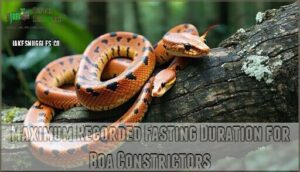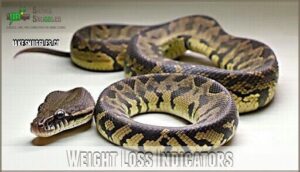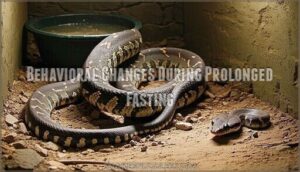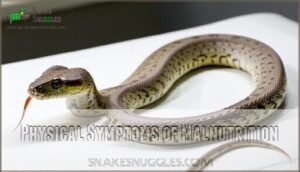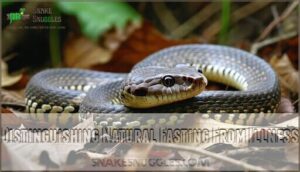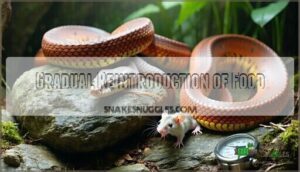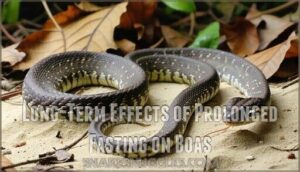This site is supported by our readers. We may earn a commission, at no cost to you, if you purchase through links.
 Your red-tailed boa constrictor can survive without eating for an impressive 6 months or longer, while you’d barely last a few weeks without food – making these reptiles true champions of the fasting world.
Your red-tailed boa constrictor can survive without eating for an impressive 6 months or longer, while you’d barely last a few weeks without food – making these reptiles true champions of the fasting world.
These powerful snakes possess incredibly efficient metabolisms that slow down during food shortages, allowing them to tap into stored fat reserves like a natural backup battery.
Adult boas handle extended fasting better than juveniles, who need regular meals for growth.
Temperature, breeding cycles, and overall health all affect how long your boa can safely fast.
However, distinguishing between normal fasting and concerning appetite loss requires understanding several key warning signs.
Table Of Contents
- Key Takeaways
- Natural Fasting Abilities of Red Tailed Boa Constrictors
- Maximum Recorded Fasting Duration for Boa Constrictors
- Age and Size Impact on Fasting Tolerance
- Environmental Factors Affecting Boa Constrictor Feeding
- Breeding Cycle Effects on Feeding Patterns
- Captive Vs Wild Boa Constrictor Feeding Habits
- Signs of Unhealthy Fasting in Red Tailed Boas
- Refeeding Strategies After Extended Fasting Periods
- Long-Term Effects of Prolonged Fasting on Boas
- Frequently Asked Questions (FAQs)
- How long can a boa constrictor go without eating?
- How often do boa constrictors eat?
- Do boa constrictors eat after shedding?
- Do boa constrictors eat in winter?
- Do boa constrictors kill prey?
- What happens if a boa constrictor eats too much?
- How often do red-tailed boas eat?
- What snake can go the longest without eating?
- How long can I go without feeding my snake?
- Are red tail Boas a constrictor?
- Conclusion
Key Takeaways
- Your red-tailed boa can survive 6+ months without food thanks to its incredibly slow metabolism that drops by 70% during fasting periods, allowing it to tap into stored fat reserves like a natural backup battery.
- Adult boas handle fasting much better than juveniles – while adults can safely go 2-4 weeks between meals, young boas need feeding every 5-7 days due to their rapid growth and higher metabolic demands.
- Environmental factors like temperature and breeding cycles dramatically affect your boa’s appetite – cooler temperatures naturally extend fasting periods, while males often refuse food completely during breeding season from April to August.
- You need to watch for warning signs that distinguish normal fasting from dangerous appetite loss – look for significant weight loss, visible spine or ribs, triangular body shape, lethargy, and behavioral changes that indicate your snake needs immediate attention.
Natural Fasting Abilities of Red Tailed Boa Constrictors
You’ll find that red-tailed boa constrictors have evolved remarkable fasting abilities that let them survive months without eating in their natural habitat.
Their slow metabolism and efficient fat storage systems allow them to reduce their energy needs by up to 70% during food shortages, making them incredibly resilient hunters.
Nature’s ultimate survivalists, red-tailed boas transform into living batteries during lean times, powering through months without a single meal.
Wild Feeding Patterns
In nature, red-tailed boa constrictors master the art of prey ambush, waiting motionless for days or weeks.
Opportunistic feeding defines their survival strategy—they’ll tackle anything from rodents to birds when chances arise.
Seasonal scarcity during dry periods forces these snakes to adapt their hunting patterns.
Unlike your pet’s regular meals, wild boas can’t predict their next feast.
This unpredictable boa constrictor feeding schedule has shaped their remarkable ability to survive extended periods without food in harsh environments.
Metabolic Adaptations
The red-tailed boa’s body becomes a survival machine during extended fasting periods.
Their metabolic rate drops by up to 70%, allowing remarkable energy conservation when food becomes scarce.
Here’s how metabolic adaptation works in boas:
- Organ shrinkage reduces energy demands substantially
- Digestion efficiency maximizes nutrient absorption from previous meals
- Glucose regulation maintains stable blood sugar levels
- Snake fasting triggers cellular recycling processes
This boa digestion system guarantees survival through tough times.
Fat Storage Mechanisms
Think of your boa constrictor as nature’s ultimate prepper – storing energy like a biological savings account.
Their fat storage mechanisms showcase remarkable fasting adaptation through specialized adipose tissue distribution:
- Subcutaneous fat layers beneath the skin
- Abdominal fat bodies surrounding internal organs
- Tail fat deposits for emergency energy reserves
- Organ storage systems maximizing lipid metabolism
These survival strategies transform your snake into a living battery, powering months-long fasts through efficient metabolic adaptation and strategic fat placement.
Seasonal Variations in Feeding
Your red tailed boa’s appetite changes like clockwork throughout the year.
Winter Slowdown means longer gaps between meals, while Summer Feasting brings regular feeding schedules.
Breeding Appetite fluctuates during spring mating season, and Molting Impact temporarily reduces hunger.
Understanding these seasonal eating patterns helps you manage your boa constrictor feeding routine effectively.
| Season | Feeding Frequency | Metabolic Rate | Prey Abundance | Behavior Changes |
|---|---|---|---|---|
| Spring | Every 2-3 weeks | Moderate | Increasing | Breeding focus reduces appetite |
| Summer | Weekly | High | Peak | Active hunting, regular meals |
| Fall | Every 10-14 days | Decreasing | Declining | Preparation for winter |
| Winter | Monthly | Lowest | Scarce | Extended fasting periods |
| Year-round | Variable | Fluctuating | Seasonal | Boa constrictor diet adapts naturally |
Maximum Recorded Fasting Duration for Boa Constrictors
You’ll discover that red-tailed boa constrictors can survive without food for remarkably long periods, with documented cases showing healthy adults fasting for six months or more.
Scientists have recorded these impressive fasting abilities through controlled studies that reveal how boas’ slow metabolism and fat storage systems allow them to endure extended periods without eating, which is made possible by their fat storage systems.
Scientific Studies on Fasting Boas
Researchers studying snake feeding habits have uncovered fascinating data about boa constrictor fasting abilities.
Studies show red tailed boa specimens can survive six months without food through dramatic metabolic rate reductions.
Scientists observed changes in gene expression and fasting hormones during extended periods.
Research on energy expenditure reveals how these snakes maintain essential functions while dramatically slowing their gut microbiome activity throughout prolonged fasting cycles.
Fasting in other organisms can lead to intestinal stem cell regeneration.
Factors Affecting Fasting Duration
Several factors determine how long your boa constrictor can safely fast. Age plays a major role – adults handle extended periods better than juveniles who need consistent nutrition. Health status affects fasting tolerance, as parasites or illness reduce duration. Temperature directly impacts their metabolism and feeding needs.
Key factors influencing fasting duration include:
- Prey Size – larger meals extend fasting periods naturally
- Hydration Levels – proper water intake supports longer fasts
- Enclosure Stressors – environmental stress shortens safe fasting time
Your snake’s individual needs vary substantially.
Physiological Changes During Extended Fasts
During extended fasts, your red-tailed boa transforms into a metabolic master.
Your boa becomes nature’s ultimate survivor, shutting down non-essential systems while living off stored fat reserves.
Its body drastically reduces energy consumption through organ shutdown and slowed digestive changes. The snake’s immune response weakens slightly, but fat reserves sustain essential functions.
Here’s what happens during reptile starvation:
| Body System | Fasting Changes |
|---|---|
| Metabolic Rate | Drops 70% below normal |
| Organ Function | Non-essential organs slow |
| Energy Conservation | Breaks down muscle tissue |
| Digestive System | Stomach acids reduce substantially |
| Fat Reserves | Primary fuel source activated |
These metabolic adaptations showcase incredible snake metabolism efficiency.
Comparison With Other Snake Species
Red-tailed boas can fast 36-96 days, but they’re not champions among snakes.
Ball pythons hold impressive records, surviving eight months without food, while African rock pythons can last two years after massive meals.
Rat snakes and rattlesnakes reduce metabolic rates by 72% during six-month fasts.
Size variation matters—larger pythons typically outlast smaller ones.
These fasting adaptations reflect different hunting strategies, habitat influence, and prey availability across snake species in wild vs captivity conditions.
Red tail boas are often categorized as either BCI or BCC, influencing their care.
Age and Size Impact on Fasting Tolerance
Your boa’s age and size directly determine how long it can safely go without food.
Young boas need meals every 5-7 days because they’re growing rapidly, while adult boas can comfortably fast for several weeks due to their larger body mass and slower metabolism.
Juvenile Vs Adult Fasting Capabilities
Age dramatically impacts how long your boa constrictor can safely fast.
Juvenile boas have higher metabolic rates and smaller fat reserves, making extended fasting riskier than for adults. Their rapid growth stages create greater nutritional needs, while adults can tap into larger energy stores during meal refusal periods.
Key differences in boa constrictor feeding patterns include:
- Juveniles require weekly meals due to accelerated metabolism and weight loss risks
- Adults can safely fast 2-4 weeks with established fat reserves supporting appetite loss
- Feeding frequency must match each life stage’s unique fasting risks and nutritional demands
Body Mass and Fasting Endurance
Your boa’s body mass directly impacts how long it can survive without food.
Larger boas store more fat reserves, allowing them to endure extended fasting periods better than smaller ones.
Weight and fasting tolerance go hand in hand – heavier snakes maintain their body condition score longer during feeding refusal.
However, muscle mass loss becomes concerning after several weeks without food.
Hydration impact affects metabolism, while fat reserve depletion signals when boa constrictor health requires immediate attention through careful weight monitoring.
Growth Rate Influence on Feeding Frequency
Just like body mass affects fasting endurance, growth rate directly determines how often your boa constrictor needs to eat.
Fast-growing juveniles burn through energy quickly, requiring frequent meals to support their development. Adult metabolism slows considerably, allowing longer periods between feedings.
Here’s how growth spurts influence boa constrictor feeding schedules:
- Neonate feeding occurs every 5-7 days during rapid early growth
- Juvenile schedules extend to 7-14 days as growth rate moderates
- Adult metabolism allows 4-6 weeks between meals once full size is reached
Monitor your boa constrictor size changes to adjust prey size and feeding frequency appropriately for ideal boa constrictor health.
Nutritional Reserves in Different Life Stages
Your boa’s nutritional reserves change dramatically throughout its lifespan.
Neonate reserves are minimal, requiring frequent feeding every 5-7 days. Juvenile stores gradually increase, extending fasting tolerance to weeks.
Adult fat deposits allow months-long fasts during breeding impact periods.
This growth correlation affects boa constrictor feeding schedules and metabolic rate adjustments.
Understanding your snake’s nutritional needs at each stage helps optimize feeding frequency and supports healthy boa constrictor lifespan.
Environmental Factors Affecting Boa Constrictor Feeding
Your boa’s environment controls when and how often it’ll eat, with temperature drops naturally slowing its metabolism and extending fasting periods.
You’ll notice seasonal changes affect your snake’s appetite, as cooler temperatures and humidity shifts mirror the natural cycles that trigger longer breaks between meals, influenced by temperature.
Temperature and Humidity Effects
Your snake’s environment directly impacts its appetite more than you might realize. Temperature and humidity levels control whether your boa will eat or refuse meals entirely.
Environmental conditions affect boa constrictor feeding in these critical ways:
- Ideal Temperature ranges of 84-85°F ambient with 95-100°F basking spots facilitate proper digestion
- Humidity Levels between 40-60% prevent dehydration that causes digestion interference
- Shedding Issues from poor humidity lead to feeding refusal for weeks
- Enclosure Management with consistent monitoring prevents most feeding problems
When temperature drops below 80°F or humidity falls under 40%, your boa’s metabolism slows dramatically, causing feeding refusal that lasts months.
Consistent monitoring using a reliable temperature gauge is essential to maintain a healthy environment.
Seasonal Variations in Appetite
Just like bears prepare for winter, your red-tailed boa’s appetite follows nature’s calendar.
Winter metabolism slows dramatically when temperature drop occurs, extending feeding intervals from weekly to monthly.
During breeding season (spring through summer), males often refuse meals entirely while females eat sparingly.
| Season | Feeding Frequency | Metabolic Rate | Appetite Level | Special Notes |
|---|---|---|---|---|
| Winter | Every 4-6 weeks | 30% slower | Low | Dormancy period |
| Spring | Every 2-3 weeks | Increasing | Variable | Breeding season starts |
| Summer | Every 1-2 weeks | Peak activity | High | Summer feeding prime time |
| Fall | Every 2-3 weeks | Declining | Moderate | Seasonal adjustments needed |
| Shedding | Skip 1-2 meals | Normal | None | Shedding cycle affects appetite |
Habitat Changes and Feeding Behavior
Environmental changes dramatically alter your boa’s feeding habits and natural behavior.
Habitat fragmentation from urbanization impact and deforestation effects creates prey scarcity, forcing boas to adapt their feeding schedules.
Climate change compounds these challenges, leading to feeding refusal causes that puzzle many owners.
Environmental factors affecting feeding behavior include:
- Habitat destruction reducing available prey populations
- Temperature shifts altering metabolic rates and digestion
- Seasonal prey migration patterns disrupting regular feeding cycles
- Stress from environmental changes triggering appetite suppression
Prey Availability and Feeding Frequency
Prey availability directly influences your boa constrictor’s feeding schedule and nutritional needs.
During prey scarcity, wild boas adapt by extending time between meals, while captive diets remain consistent.
Your snake’s meal size should match natural feeding frequency patterns.
Understanding prey availability helps you recognize normal feeding refusal causes versus health issues, ensuring proper snake digestion and meeting your boa’s true nutritional requirements.
Captive boas benefit from supplementation to avoid deficiencies.
Breeding Cycle Effects on Feeding Patterns
When you’re breeding red-tailed boas, you’ll notice their eating habits change dramatically during mating season from April to August.
Male boas often refuse food completely during this time, while pregnant females eat much less throughout their 120-day gestation period.
Male Fasting During Breeding Season
During mating season, your male boa’s feeding habits change dramatically due to hormonal influence and energy expenditure focused on sperm production.
Snake feeding refusal becomes common as males prioritize mate searching over meals, with feeding frequency dropping substantially during breeding season.
- Testosterone surges: Hormones redirect focus from food to reproduction
- Territory patrols: Males spend energy defending prime breeding spots
- Courtship rituals: Complex mating dances consume substantial energy reserves
- Post-mating recovery: Exhausted males need time to rebuild strength
Female Appetite Changes During Gestation
While males fast during breeding season, pregnant females experience different challenges.
Gestation Appetite Loss becomes common as Hormonal Appetite Changes redirect energy toward developing embryos.
Gravid Boa Behavior shows decreased interest in food throughout the 120-day pregnancy period.
A balanced diet addresses essential vitamin needs.
This natural shift in feeding habits helps manage energy reserves, with Clutch Size Impact influencing how severely snake appetite decreases during gestation.
Post-Partum Fasting in Females
After your female boa gives birth, she’ll likely turn down meals for several weeks.
This postpartum recovery period helps her rebuild energy reserves depleted during pregnancy.
Weight loss during this time is normal as her body prioritizes maternal health over feeding.
Don’t worry – this natural fasting actually supports neonate survival and future breeding success.
Hormonal Influences on Feeding Behavior
Hormones dramatically reshape your boa’s feeding habits throughout their reproductive cycle.
Testosterone influence drives males to fast during mating season, while estrogen and appetite changes affect females differently.
Progesterone effects reduce hunger in gravid females, and cortisol impact from stress factors can trigger complete meal refusal.
Hormonal imbalance often causes unexpected weight loss when natural cycles go awry.
These hormonal influences explain why your snake’s appetite vanishes during breeding periods—it’s biology, not illness.
Captive Vs Wild Boa Constrictor Feeding Habits
You’ll find that captive boa constrictors eat much more regularly than their wild cousins, who must survive unpredictable food shortages in nature.
While wild boas can fast for months during dry seasons or when prey is scarce, your pet boa enjoys consistent meals every 1-2 weeks without the survival pressures of hunting.
Differences in Prey Availability
Wild red-tailed boas face dramatic prey scarcity during dry seasons, forcing them to become opportunistic feeders with incredible wild survival strategies.
Their diet breadth adapts to habitat variation and seasonal abundance patterns, while food availability determines their feeding habits.
| Environment | Prey Availability | Adaptation Strategy |
|---|---|---|
| Wild Rainforest | Seasonal fluctuations | Extended fasting periods |
| Captive Setup | Consistent supply | Regular feeding schedule |
| Dry Season | Limited prey size options | Metabolic slowdown |
Feeding Frequency in Captivity
Captive schedules offer you complete control over your boa’s nutrition. Unlike wild hunting patterns, you’ll establish consistent feeding frequency based on age and temperature.
Neonate feeding occurs every 5-7 days, while adults eat every 2-3 weeks. Seasonal adjustments reduce winter meals by half.
Flexible schedules prevent feeding refusal causes by matching your snake’s natural rhythms. Finding the right boa constrictor food is essential for their health.
| Age Group | Feeding Frequency | Temperature Considerations |
|---|---|---|
| Neonates | Every 5-7 days | Maintain consistent warmth |
| Adults | Every 14-21 days | Reduce frequency in winter |
The provided table outlines the feeding frequency and temperature considerations for different age groups of boas, emphasizing the importance of a consistent schedule and proper temperature management to ensure the well-being of your boa.
Overfeeding Risks in Captive Boas
Overfeeding your boa creates serious health risks that’ll shorten its lifespan.
Too much food leads to obesity, fatty liver disease, and regurgitation issues that stress your snake’s digestive system.
| Health Risk | Symptoms | Long-term Impact |
|---|---|---|
| Obesity | Thick body, fat rolls | Growth problems, reduced mobility |
| Fatty Liver Disease | Lethargy, poor appetite | Organ damage, shortened lifespan |
| Regurgitation | Vomiting meals | Digestive tract damage |
| Joint Strain | Limited movement | Permanent mobility issues |
| Stunted Growth | Abnormal development | Lifelong health complications |
Mimicking Natural Feeding Patterns
Smart keepers replicate natural cycles to keep their boas healthy. You’ll want to adjust your boa constrictor feeding schedule seasonally, reducing winter meals and increasing summer frequency.
Varied prey sizes and types mirror wild behaviors, while environmental enrichment encourages natural hunting instincts. Captive boas benefit from frozen-thawed prey, ensuring safer feeding practices.
| Feeding Aspect | Wild Pattern | Captive Application |
|---|---|---|
| Seasonal Feeding | Summer abundance, winter scarcity | Reduce winter feeding frequency |
| Varied Prey | Multiple species available | Rotate between mice and rats |
| Natural Cycles | Temperature-driven appetite | Adjust feeding routine with seasons |
These adaptive strategies support your snake’s feeding behavior while maintaining proper feeding guidelines year-round.
Signs of Unhealthy Fasting in Red Tailed Boas
While your red-tailed boa can naturally fast for months, you’ll need to recognize when this normal behavior crosses into dangerous territory.
You can spot unhealthy fasting by watching for significant weight loss, changes in body shape from round to triangular, lethargy, and visible spine or rib bones protruding through the skin.
Weight Loss Indicators
To spot weight loss in your boa, check its body shape and muscle tone.
An underweight snake may have visible spine ridges, triangular body shape, or reduced muscle mass.
Look for excessive skin wrinkles or lack of usual fat deposits.
Regular weight monitoring helps track changes.
If you notice concerning weight changes, consult a vet to guarantee your boa’s health stays on track.
Behavioral Changes During Prolonged Fasting
Beyond weight loss, your boa’s behavior tells a story. Activity levels drop dramatically as they conserve energy.
You’ll notice increased snake stress and changes in social behavior – they become more withdrawn and defensive. Their basking habits shift, spending less time under heat sources.
These snake feeding refusal symptoms indicate your pet’s instinctive survival mode has kicked in.
- Reduced movement and exploration patterns
- Increased defensive posturing when approached
- Less time spent basking under heat sources
- Heightened stress indicators like rapid breathing
- Regurgitation risk increases due to weakened digestion
Physical Symptoms of Malnutrition
Malnutrition in your boa shows clear physical warning signs you can’t ignore.
Weight loss becomes obvious when ribs feel prominent under loose skin.
Muscle atrophy creates a triangular body shape instead of the healthy rounded appearance.
Spinal prominence means bones stick out noticeably along the back.
Dehydration signs include sunken eyes and sticky mouth membranes.
Lethargic behavior accompanies these snake health issues, making weight tracking essential for monitoring snake nutritional needs.
Distinguishing Natural Fasting From Illness
Watch for concerning behavior changes that signal illness rather than natural fasting in your boa constrictor.
Weight loss combined with lethargy, difficulty shedding, or unusual physical symptoms indicates health issues requiring attention.
Snake feeding refusal causes include parasites, infections, or poor husbandry conditions.
Conduct regular health checks and consult a veterinarian when fasting exceeds normal patterns or accompanies worrying signs.
Refeeding Strategies After Extended Fasting Periods
When your red-tailed boa finally breaks its extended fast, you’ll need to carefully plan its return to regular feeding.
You can’t simply offer a full-sized meal right away, as this approach risks serious digestive problems and potential regurgitation in your snake, which could lead to further complications if not managed properly with a well-planned return.
Gradual Reintroduction of Food
Reintroducing food after extended fasting requires patience and careful planning. Your boa’s digestive system needs time to readjust, so don’t rush the process.
A proper refeeding schedule helps minimize stress while ensuring smooth digestion recovery. Proper prey size is essential for successful refeeding.
- Start with smaller initial prey than normal feeding guidelines suggest
- Monitor hydration importance and provide fresh water constantly
- Track digestion monitoring through weight checks and behavioral observations
Prey Size and Type Considerations
After breaking a fast, you’ll want to offer smaller prey than usual.
Start with prey that’s 75% of your boa’s normal meal size. Frozen mice work better than live options since they’re easier to digest.
| Prey Type | Post-Fast Size |
|---|---|
| Mice | 25-50g |
| Rats | 50-100g |
| Chicks | 20-40g |
This approach prevents digestive shock while providing essential nutritional value.
Monitoring Digestion After Long Fasts
After choosing appropriate prey sizes, you’ll need to watch your boa’s digestion closely.
Their metabolism kicks back into gear slowly, making Regurgitation Risks higher than usual.
Monitor these key indicators:
- Fecal Analysis – Check for normal consistency and frequency
- Hydration Levels – Verify adequate water intake supports Gut Health
- Enzyme Production – Watch for signs of improved boa constrictor digestion
Patient observation prevents complications during this delicate recovery phase.
Nutritional Supplementation Post-Fasting
After your boa’s digestive system has adjusted, you’ll want to address potential nutritional deficiencies through targeted supplementation.
Supplement types like calcium and vitamin D help prevent malnutrition, while dosage guidelines guarantee safety. Digestive support aids nutrient absorption, and hydration importance can’t be overstated for snake nutrition recovery.
Many owners find that proper digestive supplements can aid in a snake’s recovery.
| Key Focus | Benefits |
|---|---|
| Rehydration | Prevents dehydration |
| Digestive support | Aids in nutrient absorption |
| Mineral balance | Ensures bodily functions |
| Multivitamin benefits | Boosts overall recovery |
Always seek veterinary oversight before introducing supplements to avoid complications.
Long-Term Effects of Prolonged Fasting on Boas
When you’re considering how long your boa can safely fast, you’ll want to understand the serious consequences that extended periods without food can have on their overall health and development.
Prolonged fasting doesn’t just affect your snake’s weight—it can impact their growth rate, reproductive success, immune system strength, and even their lifespan if these periods happen too frequently.
Impact on Growth and Development
Extended fasting substantially stunts your redtailed boa constrictor’s growth rate and development.
Snake growth becomes compromised as muscle mass decreases and bone density weakens.
Organ development suffers, creating long-term health issues.
Shedding frequency reduces dramatically, indicating poor snake body condition.
Snake malnutrition from prolonged snake feeding interruptions can permanently affect your boa’s size and overall physical development throughout its lifetime.
Reproductive Consequences of Extended Fasting
When your boa fasts for months, breeding success takes a hit.
Hormonal disruption from prolonged fasting affects egg development and fertility impact. Females may produce fewer viable eggs, while males show reduced breeding drive.
Poor metabolism during extended fasting can lead to malnutrition, directly affecting offspring health.
Proper health management guarantees your boa’s reproductive future stays strong.
Immune System Effects
Prolonged fasting disrupts your boa’s fasting immunity, creating a domino effect throughout their body.
When metabolic rate drops during extended snake feeding refusal, the immune system weakens substantially.
This immune suppression leaves your snake vulnerable to various health threats that a well-fed boa would typically fight off.
- Increased infection risk from weakened defenses
- Disrupted gut microbiome affecting digestion
- Heightened stress response impacting overall health
- Malnourishment reducing disease-fighting capabilities
- Compromised recovery from illness or injury
Lifespan Implications of Frequent Long Fasts
Beyond immune system impacts, frequent long fasts create serious lifespan reduction risks.
Extended fasting causes organ damage and growth stunting in your boa. Reduced fertility and immune suppression compound these problems.
While boas possess remarkable survival skills, consistent feeding frequency supports proper digestion and ideal metabolic rate analysis.
You’ll maximize your snake’s longevity by avoiding repeated prolonged food deprivation periods.
Frequently Asked Questions (FAQs)
How long can a boa constrictor go without eating?
Like a patient hunter waiting for the perfect moment, your boa constrictor can survive 2-3 months without food.
Their slow metabolism naturally handles fasting periods, though you’ll want to monitor their weight and health closely, ensuring you can identify any issues related to their slow metabolism.
How often do boa constrictors eat?
Your boa’s feeding schedule depends on age and season. Young boas eat every 5-7 days, while adults need meals every 10-14 days. During cooler months, you’ll feed them less frequently.
Do boa constrictors eat after shedding?
Yes, your boa will typically resume eating after shedding.
During the shedding process, they often refuse food, but once their new skin emerges, their appetite usually returns within a few days.
Do boa constrictors eat in winter?
Winter acts like nature’s pause button for your boa’s appetite.
Your snake’s metabolism naturally slows during cooler months, so they’ll eat less frequently—sometimes going four to eight weeks between meals without concern.
Do boa constrictors kill prey?
You’ll find that boa constrictors are powerful hunters who kill their prey through constriction.
They wrap around their victim and squeeze until blood flow stops, causing death before swallowing the meal whole, which can be seen as a powerful display of their hunting ability.
What happens if a boa constrictor eats too much?
When you overfeed your boa, it’ll develop fat deposits and excessive skin wrinkles, leading to Fatty Liver Disease.
You’ll notice ring-shaped fat rolls and a loss of that healthy square body shape your snake should maintain.
How often do red-tailed boas eat?
Your red-tailed boa’s dining schedule isn’t exactly demanding.
Adults eat every 10-14 days, while youngsters need meals every 5-7 days.
During cooler months, you’ll stretch feeding intervals to 4-8 weeks between servings, which can be considered a demanding adjustment.
What snake can go the longest without eating?
You’ll find the Okinawa habu holds the record for longest fasting, surviving over three years without eating. However, reticulated pythons and ball pythons commonly fast for 22+ months.
How long can I go without feeding my snake?
Your snake won’t starve overnight!
Adult boas can safely go 2-4 weeks between meals, while juveniles need feeding every 7-10 days.
Monitor their weight and body condition closely during any extended fasting period.
Are red tail Boas a constrictor?
Yes, you’re dealing with a true constrictor species.
Red-tailed boas kill their prey by wrapping around and squeezing until circulation stops.
They’re powerful constrictors, not venomous snakes like some people assume.
Conclusion
Understanding how long a red tailed boa constrictor can go without eating empowers you to recognize normal fasting versus concerning appetite loss.
While your boa’s impressive 6-month fasting ability stems from remarkable metabolic adaptations, you shouldn’t rely on this exclusively.
Monitor your snake’s weight, behavior, and overall health regularly, as age, temperature, and breeding cycles all influence feeding patterns.
By respecting your boa’s natural fasting instincts while staying alert to warning signs, you’ll maintain a healthy, thriving serpent companion, and ensure you can distinguish between normal behavior and potential health issues related to metabolic adaptations.
- https://www.animalsathome.ca/boa-constrictor-feeding-chart/
- https://www.reddit.com/r/snakes/comments/9ej1wk/colombian_boa_constrictor_not_eating/
- https://reptifiles.com/boa-constrictor-care/what-do-boa-constrictors-eat/
- https://www.quora.com/How-long-can-a-red-tail-boa-constrict-for-Can-it-ever-stop-once-it-starts-squeezing-its-prey-or-does-it-need-to-rest-after-a-certain-amount-of-time-passes
- https://www.justanswer.com/pet-reptile/3z364-red-tail-boa-gone-without-food-month-when.html

